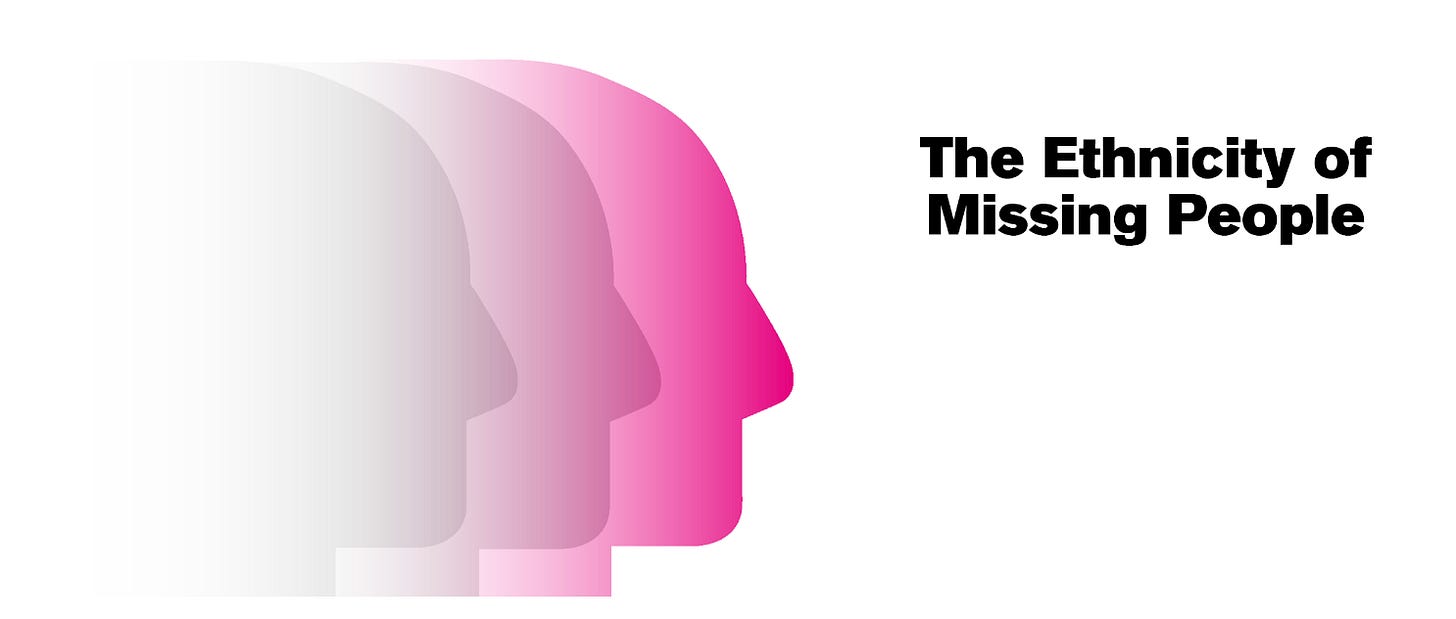SW1 Bitesize: The Ethnicity of Missing People
Is racial bias responsible for ethnic minorities being more likely to go missing?
A recent report by the charity Missing People says that ethnic minorities go missing for longer than white people, are less likely to be found by police, and are less likely to be recorded as being at risk.
Using Freedom of Information requests they found that, although black people only make up 4% of the general population, they make up 15% of all missing people. Data from 2021-22 showed that 20% of black children were missing for more than 48 hours, compared to 14% of white children, while 4% of black children were missing for over a week compared to 1% of white children.
Meanwhile only 16% of missing black children and 19% of missing Asian children were found by the police, compared to 23% of missing white children. When it came to adults, the police found missing black adults 31% of the time, compared to 39% of missing whites.
This was illustrated with the example of Richard Okorogheye, a 19 year old black man who went missing in 2021. Despite his mother reporting him missing the next day, the police recorded his case as low risk. His body was found in Epping Forest, Essex, a few weeks later.
Jo Youle, CEO of Missing People, said that the data “raises serious concerns about the safety of people from minority ethnic groups who go missing”. Jahnine Davis, founder of Listen Up, a consultancy which contributed to the report, said that ““Children are going missing . . . but due to the colour of their skin they are not provided protection. This is racism”. But is it?
In the case of Richard Okorogheye, there is no proof of racism. A fuller account of his story adds important details: he was “struggling to cope” with lockdown because his sickle cell disease meant that he was only allowed to leave the house for his medical appointments and he took care to lock his door when he left, taking his wallet, bus pass and bank card with him.
His body was recovered from Wake Valley Pond in Essex. The police said they were treating his death as unexplained, that no third party was involved, and that there was no sign of physical trauma.
Following complaints by his mother, the IOPC conducted an investigation. It found the police treated his case as low risk for too long, that a call handler had inaccurately recorded his medical condition as a less severe one, while other police employees had failed to appreciate the significance of his condition. Although his mother alleged that racial bias was involved, the IOPC found no evidence of this. None of the police employees involved received any disciplinary action, all getting enhanced training instead.
As for the report by Missing People, the key indicator of issues with the analysis are the use primarily of black and white alone for comparisons. As page 7 of the report makes clear, although black people are much more likely to go missing than white people, Asian people are less likely to go missing than both. Similar statistics can be found throughout: black children are more likely to be in care or go missing while in care than whites, but Asians are less likely than both.
While missing Asian people also fare worse on some metrics - such as being less likely to be found by the police than whites, although still more than black people, or being less likely as adults to be found by police than whites or blacks - the lack of a cohesive trend suggests that race is not the crucial factor. If racism really was responsible then we’d expect to see Asian missing people always doing worse than whites ones, which we don’t.
Some possibilities can be seen in the data. For instance, police data shows that white children are much more likely to have a child sexual exploitation flag (local authority data shows white and Asian children both being more likely to have a CSE flag than black children are). As we know from grooming gang cases, children go missing, are abused, then often returned within a short period. This could help explain why white children are more likely to go missing for shorter periods.
Similarly, black children are much more likely to have a criminal child exploitation flag in local authority data (although in police data, white children are the most likely to have this flag). This could reflect involvement in ‘county lines’ drug gangs, where the child is often away transporting or selling drugs for extended periods. This could help explain why black children are more likely to go missing for longer periods.
It’s worth looking at Listen Up, the consultancy who helped the report. They say on their website that they work to embed “intersectionality & systemic thinking in child protection practice, policy & research”. In particular they wish to amplify the voices of “minoritised and marginalised children”. In other words, they primarily see the world through a racial lens, unsurprisingly leading to a report which only tries to explain its data in racial terms. As the saying goes, when you have a hammer then everything looks like a nail. That’s no way to sensibly inform policy however.


